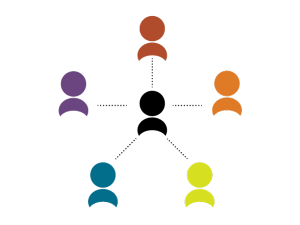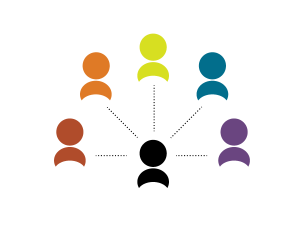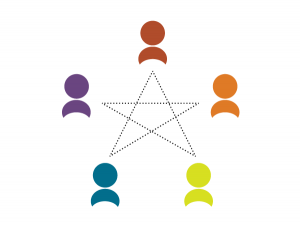Did you enjoy the outdoors—or just the chance to stretch your legs outside of the classroom—this past summer? Thinking of your students or workshop participants as athletes might yield new ideas for how to approach growth and fatigue in design learning environments.
Let’s say you’re hired to develop new design capacities in a group of individuals. You set milestones, prepare materials, and begin. You stay flexible, make adjustments in response to unexpected advances or setbacks, and find a balance between emphasizing design capacities and design outcomes that fits the learning context.
This could be a classroom of students who will pursue professional careers in design, but it could also apply to a workshop environment where folks from non-design backgrounds build specific literacies that are needed to produce and deliver design outcomes. In either case, and all the cases in between, when we teach design our deliverable is a “design capable” person. Design education is slowly becoming less siloed, and teaching outcomes more heterogenous. As we welcome smart practices as preferred alternatives to “best” practices, and embrace all the pathways a design learner might take to arrive at an outcome, it becomes more difficult to know when we have delivered a rigorous learning experience.
I think about this a lot. After three higher education degrees, I’ve been on the receiving end of both excellent and poor learning experiences. As a practitioner of participatory design I work with experts from many different fields and young people to create informed and contextually thoughtful design outcomes. So much of what I do is bridging the expectations of my clients and the whole ecosystem of needs and opportunities that students and workshop participants bring to the studio. I design because of the access to human encounters that comes with the title of designer. I’m thoroughly captivated by possibility, change, revision, and reflection, and because I love this work so much it becomes precious. Sometimes I lose sight of the mechanics of what’s actually happening when I work.
A parallel background of mine is in athletics. I taught swimming for a decade, coached Special Olympics, and have since become a serious cyclist. For years it didn’t occur to me that I have a way of thinking about skill development that applies to both design and sports. Upon being asked what I do when time is running out, and the group I’m working with isn’t on track to hit their target learning outcomes, I immediately thought about athletic training and coaching.
These four personas help me consider contexts, relationships and motivations that produce a well-rounded athlete, and a well-rounded designer:

Educator Persona: Trainer
A trainer works with groups and individuals by running through exercises that increase strength, flexibility and stamina based on where the person is in their development, and what goals they need to meet. It’s individualized, occurs in a private setting, and entirely about preparing an individual for the future through the development of specific skills. Great trainers are high-energy, focused on the immediate tasks, pay close attention to growth and success. A successful series of encounters with a trainer develops personal goals and long-term growth.
Trainers use exercises that are brief, quick, and intense, mostly where the person being trained works alone, but do include some moments in small groups. Pairing people with similar skill levels, or making exercises that can be modified to meet people where they are, is ideal. Emphasis is on activity and live feedback. Jealousy, admiration, and competition between individuals in a training session are learning opportunities. The way a trainer points out the skills and success of other people in the session influences whether these learning opportunities are productive or destructive to individual growth. How people treat each other when they’re all focused on their own path and their next goal is really important to the quality of the learner’s experience. To work with a trainer is to appreciate how intense sessions of guidance and practice really do pay off, and emphasizes how everyone can benefit from intense, focused, developmental work.

Learner Persona: Athlete
Athletes have whole careers. Some are short, some are long, some burn out or stop because of injury. Some are former athletes turned coaches. They rely on guidance but ultimately are responsible for themselves. Nobody stays with the same coach or team forever, and for an athlete to know how to manage their career is as important as being good at their sport, good at their specialties, and happy with the life choices they make. They train hard, join teams that help them develop their experiences and achieve professional goals, and are committed to their practice. An athlete knows that their relationship with their coaches, trainers and teams are essential to success, but some athletes are more interested in success, while others are motivated by the relationships. What is the ideal athlete? Everyone interested in athletics has their own perspective. This might be one of the most important questions a coach or trainer can answer for themselves.

Educator Persona: Coach
A coach works with a team of individuals to help them collectively reach the highest possible achievement in a public setting, at a specific time. Coaches are focused on the finish line, the outcome, the success of the group under highly stylized and unique conditions. These conditions don’t match the real world, but are taken extremely seriously and can result in publicity and reputation-building success. A coach is not a trainer when they are coaching. There’s no time for personalized, growth oriented work during a competition. The public performance of skill, and the pursuit of success, is more important than having every individual improve their skills. The strongest and fastest team members lead the team to success, but everyone in the group wins or loses as a team.
Coaches rely on the experiences learners have developed with trainers, and push everyone on the to the farthest extent of their strength, flexibility and stamina. Great coaches encourage everyone on the team to work their hardest, but lean on the strongest members of the team to achieve success for the team. Knowing when to work and rest team members is essential, which means a coach has to know each team member’s abilities better than they know their own. If winning isn’t possible, the coach shapes the experience to be generative, and encourage everyone to train, improve and compete again.

Learner Persona: Team
A team is a group of individuals who contribute to their collective success based on their capacity relative to the rest of the group. On a cycling team individuals are both looking to win and, sometimes at the cost of their own success, help their team win. In soccer or basketball, people want to score or help their team score. Everyone on a team is good at what they do, but each member of team offers a unique capacity or combination of capacities that contribute to the success or failure of the team in competition.
Great team dynamics are built off the admiration and competition that begins in training. In this way both trainers and coaches are responsible for developing a team’s ability to function and thrive as a unit. However, every team is made up of athletes who are on their own path, striving to achieve their own definition of success.
In the above personas I avoided using terms like junior and senior designer, art director, executive, professor, portfolio, or design awards, but my hope is that in unpacking the details of these athletic settings you might draw your own analogies and conclusions to classrooms and professional contexts.
As an MFA student I spent too much time in competition and not enough time with trainers. Even the best athletes can’t compete all the time. On my most recent design education project we spend most of our time training, so learners became fatigued and everyone wanted to get out there and compete. If your learners are struggling, read the room and identify what personas you’ve created in your learning environment. Reframe the achievement you’re all working toward, and either train or coach your learners to success.
Fatigue is real, and if the people you’re responsible for aren’t where they need to be, it’s because they’re not spending enough time training, they’re burnt out from too many games, or they don’t know where they are in their career. Be a coach or a trainer, but not both in the same moment. In every encounter be clear about your role, the learner’s role, and what success looks like for that encounter. Ultimately, they will forge their own paths, and collect challenging, generative and developmental achievements as professionals. As educators, we contribute to shaping the way our learners think about this path, and how capable they are of sustaining a lifetime practice.
 Katie Edmonds holds social science and design degrees from UC Berkeley and Parsons. Her background is in social advocacy, nonfiction storytelling and games. She’s is currently working on projects at the intersection of human centered design, urban landscapes and civic life. Find her work at katieedmonds.com.
Katie Edmonds holds social science and design degrees from UC Berkeley and Parsons. Her background is in social advocacy, nonfiction storytelling and games. She’s is currently working on projects at the intersection of human centered design, urban landscapes and civic life. Find her work at katieedmonds.com.